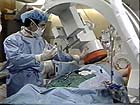| << To Blog Home >> | |
|
|
March 11, 2009 -- 7:30pm EDT Broadcasting Live Cases The venue was the "FDA Workshop: Should Live Cases be Broadcast to Meetings? Regulation in Education and Training." Recently U.S. Representative Henry Waxman and Senator Charles Grassley have been concerned about the ethical implications of broadcasting live cases involving angioplasty, stents, and related devices. So, as a pioneer in the development of this educational format, I felt obliged to offer the historical context. In fact, coronary angioplasty would not exist if it were not for the live demonstration course. The early live cases we did in the eighties focused a great deal on the patient -- Dr.'s Gruentzig, Dick Myler, etc., would have active live conversations with the patient -- the audience got to know them a bit and the human side of the patient and physician experience was transmitted, along with the medical techniques. This real-time, holistic look into the cath lab was a key educational component of these courses. And, everyone on the team and in the audience felt invested in each patient's best outcomes. Those of us who participated in creating those courses had no question While demonstration case broadcast has radically changed, it's worth looking at the effect this approach had on the profession, and identifying what factors, perhaps even guidelines, need to be present to determine its continuing potential to be an effective and ethical educational tool moving forward. My video (supported by a grant from Abbott Vascular) is currently viewable at CRTonline's version of YouTube, called CardioTube. |
|


 Last
Friday, my short video, recalling the origins of the "Live Demonstration
Course" in interventional
cardiology, was shown during the final day of
Last
Friday, my short video, recalling the origins of the "Live Demonstration
Course" in interventional
cardiology, was shown during the final day of